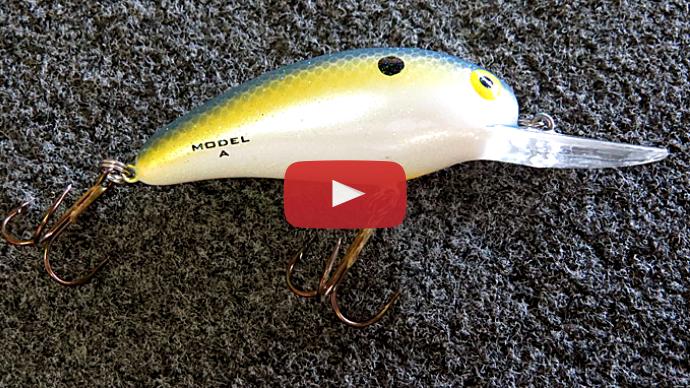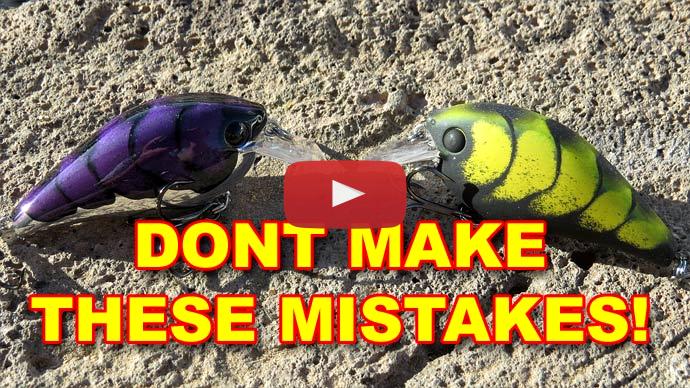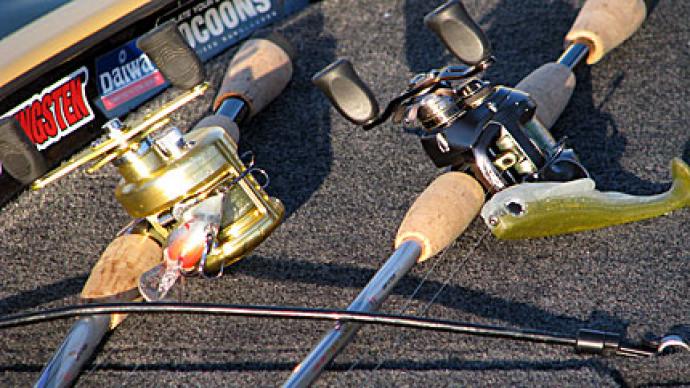Hey, folks, Glenn May here of BassResource.com, and today I wanna talk to you about the essentials that you're gonna need for crankbaiting. Now, if you're new to crankbaiting or if you've been doing it for a while, you're gonna pick up a few tips hopefully more than just a couple, but these are the things that you absolutely need to know for crankbaiting. I'm gonna talk about the rod reeling equipment. Some of the modifications I do to my crank base before I even use them and then I'm gonna go through the different techniques and retrieves we use for most crankbaits.
First, let's start with the equipment starting with the rod. The rod you want is a medium power moderate- to fast-action tip, something that looks like this, see this, see how it bends like that, that's kind of what you want, you want that nice, long bend, parabolic bend not like right up to the tip like some rods, nice long rod, that's what you want. You want that kind of give, it's for two reasons. Number one, yeah, it makes it easier to cast lighter crankbaits, but also it has that give, these crankbaits have little treble hooks on them and if you use a rod that's pretty stout, that gives the leverage for the fish when it's fighting back to be able to pull free of those hooks. So you want a rod that's kind of a spring, gives a little bit when he does those surges, to be able to keep that fish locked up and get that lunker to the boat.
This combination here is an Okuma Helios Rod with a... paired with an Okuma Helios Air Reel, great combination even though on this rod sometimes with rods you got to, it says on the side, "Hey, this is a crankbait rod, this is a jig rod," this doesn't say that exactly, but it has those characteristics of a great crankbait rod.
The other thing I have on if you noticed this is a mini-guide system, little tiny guides on it. And the reason I have these on here is because they're much more sensitive than other guides, they're closer to the blank, there's less of a lag there so there's less distance for the vibration to transfer to the blank so I can feel everything and you might think well, if you’re crankbait fishing, the fish when it hits it, he just wallops it, he's about to rip the rod right out of your hand. Well, that's true in some instances, but a lot of times, those fish will come right up, they'll swim behind the bait and they'll mouth it, they'll just grab it and immediately feel that it's not natural and blow it right back out. And you might not even feel that. Sometimes the vibration of the crankbait will go from a tick, tick, tick, tick, tick to a thud, thud, thud, thud, thud and they'll change back to a tick, tick, tick, tick that's it, that's all you feel, or sometimes it’s just the cadence of the vibration might change a little bit. And so a real sensitive rod is essential to pick up on those things.
So when you're selecting a baitcasting reel, you want one that has like a six to three or six to one gear ratio or higher. This one, in particular, this is the Okuma Helios Air Reel, it has a 7.3:1 one gear ratio. I like that for two reasons. Number one, when I make that long cast the first thing I wanna do is crank it down really fast and get that crankbait down to a running depth and then slow it down, so I can get it down faster with a higher gear ratio. Also, what I like is sometimes I like to burn back the crankbait like a vibrating crankbait, burn it back really fast so a higher crank gear ratio helps me do that.
The other thing is I use for the line I use fluorocarbon line. I like to use Tatsu Seaguar Line because fluorocarbon has a lot of different advantages for crankbaiting. First of all, like I mentioned with the sensitivity, fluorocarbon is really sensitive, and so you're gonna feel all those vibrations that I just told you about. Also, fluorocarbon is more abrasion-resistant. Now, I mentioned or I haven't mentioned yet, but I'm going to is the different areas you wanna fish you're going to be throwing in stumpy fields, you're going to be throwing in logs, pilings, rock piles, you're going to be fishing rip-rap, things like that and this line is gonna be draping across all that and it's gonna get nicked, it's gonna have some fraying and abrasion, you can't get away from that, but Seaguar Fluorocarbon Line is much more resistant to that than other lines.
And you might think, “Why don't I just use the braid?” Well, for crankbaiting, really what you wanna use is fluorocarbon because fluorocarbon is not as buoyant as other baits or other lines. As a matter of fact it kind of sinks whereas, monofilament, copolymer, braid, it has buoyancy to it and those lines are gonna prevent the lure from reaching its maximum advertised depth. Fluorocarbon on the other hand, it sinks, it's not as weighted line per se, but it does sink, it's gonna allow that bait to get to its maximum depth.
So we've talked about the line, we've talked about the rod, we'll talk a little bit about the reel. This is a baitcasting reel, I'm using 12-pound test line, freshwater spinning reels are great for 10-pound test and lighter. I like to use 12-pound test and heavier and that's what baitcasting gear is are designed for. It's also like a winch and when you're cranking all day long, that power winch it makes it easier to crank and you're not going to get as fatigued. I'm using 12-pound line because thicker diameter line it has a heavier diameter line, 15-pound, 17-pound or higher has a thicker diameter, it has more resistance in the water and that again is gonna prevent the bait from reaching its maximum depth. 12 pounds is what I wanna go with so you might think well, that logic, "Hey Glenn, why don't you use 8-pound test? 6-pound test?" Well, as I've mentioned before, you're going to bringing it across rocks, stumps, logs, those types of things and that lighter line isn't gonna hold up to that kind of abuse. 12-pound is about the minimum that you wanna go with. So that's a good all-around, all-purpose line, 12-pound fluorocarbon again straight fluorocarbon, I don't use any leaders on it that's why I can get away with using the mini-guide system here. I don't have to worry about any knots or anything trying to get through the guides.
All right, so that's the equipment. Let's talk a little bit about the baits themselves and what I do here. First off, when you get a bait, you want to check the hooks, you want to check the hooks for two things strength and sharpness. Take the hook point, and drape it across your fingernail. If it scratches it, great, if it tries to dig into your fingernail while you're scratching it, even better. You want ultra-sharp hooks. If they feel really dull, that's not a very good quality hook now, of course, you can sharpen it and I know how to sharpen them, I can do that but if it's dull right out of the box, that tells me it's made out of a soft material and that hook is gonna dull up a lot faster.
Also, what you might wanna do is take a pair of pliers and see if you can't bend the hook point out a little bit. Don't wrench on it because every hook will be able to bend at some point, but if it takes relatively ease for you to bend that hook point out, the hook out, that's not a good sign because if you got a nice lunker tied onto that crankbait, if he makes a lunge, she's apt to straighten that hook out, it can get loose. So for those type of hooks, I replace them, I just get some number four's, number six, round bend treble hooks and you can get them, Gamakatsu makes them and Mustad makes them and they're all good quality hooks, but I replace them again not all hooks need to be replaced, but check them just to make sure and those that need to be replaced I’ll definitely do.
The other thing I do is I remove the split ring. I take them right off, I don't like split rings for a couple of reasons. Number one, the knot tends to find itself right where those wires connect, and it rubs against the line and it can break the line. The other thing is I don't think split rings give the bait enough movement, they don't allow it to move as freely. So what I do is I replace it with the snap just like that, I put a snap on here and I use it for two reasons. That snap is a little bit bigger than a snap... than a split ring so it allows the bait to move a lot more freer, plus with the snap here, I can swap out baits really easily. While I'm out there fishing, I don't have to bother with re-tying, I just unhook it, drop the bait, put another one on there, I'm ready to go. It's real fast and easy, pretty effective way to crankbait fish.
All right, so we've talked about the equipment, talked about some of the modifications, now let's talk about the different retrieves that are most productive for crankbaits. Now, obviously the first thing you can do when you get a crankbait is just chunk and wind. Just throw it out there and bring it right around straight back and that can be very, very effective, a very effective way of catching fish. But a quick couple of variations on it, if you're fishing and you haven't got a bite, then you can do two things, you can just speed up the retrieve or slow it down, simple as that. Sometimes they just want it faster, sometimes they just want it slower and that's a great way to catch a lot of fish.
Another thing if you wanna do with this is you can dig it in the ground, if you're fishing say, for example, six feet of water, grab a crankbait that dives 10 feet or deeper and you wanna dig that bell into the ground, even if there isn't anything there, it's just straight flat muddy bottom, dig it into it and you want that bait to deflect and deflect off things and go off in different directions. Especially if you've got rocks, if you've got rocks, it's banging on those rocks and bouncing off and going in different directions that often triggers a bite, even if the fish aren't biting.
This is the cool thing about it, bass are instinctively programmed by nature to attack, injured and disoriented bait fish. And that's exactly what you're mimicking here. The bill of the crankbait will hit a rock, it'll stop for a minute and then it'll go off in a different direction and you keep doing it bang, bang, bang, bang, bang, it looks injured, it looks confused and that's what triggers a bite. Often, when the fish aren't even in a feeding mood, they'll hit it anyway, that's what I call force-feeding the fish to bite.
So that... if you're doing that and say for example you're in deeper water and you don't have those things to bang into, you can't get it deep enough into the ground, you can mimic that just by a stop and go, retrieve, watch my hand, you go around here and then you stop, crank it, stop, crank it, stop, that's all you're doing, very simple. And do it erratically, don't like crank, crank, crack, stop, crank, crank, crank, stop, just sometimes you make five cranks, sometimes you make two and then you stop and the longer you pause, changes, you want that erratic behavior, don't make it a methodical retrieve, just erratic behavior and that can be really good, the fish is following it, follow, follow, follow it, suddenly you stop it. It's right in his face and it has to react to it and a lot of times you get a bite right when you pause it.
Another effective retrieve is the sweep retrieve. This works the same sort of principle as stopping that bait, but this time you're using the rod to do it, cast it out there, crank it down a few feet and then just pull it back with the rod as it pauses you'll want to reel at the slack, pull back with the rod, if it pauses, reel up the slack. You can do it at different speeds, you can do it really fast really hard, but practice with it, try different types of retrieves and figure out what the fish want. It's funny because they'll hit it on a pause, you often set the hook right when you sweep the hook, sweep the rod that's kind of a cool way of doing it.
Now, the next retrieve that involves a different kind of bait. And that is a vibrating or lipless bait. I like to throw Savage Gear Soft Vibes, those work really well, but any type of vibrating bait works, what I'm talking about are these little guys.
Let me put this on real quick. Like I said, it's really easy to change them out with this, I love these soft vibes, look at this, it doesn't have rattles in it, so it doesn't give away any unnatural sounds, but look at that, it's very soft, so it looks really soft and natural in the water.
But with these, these types of baits when they fall, they fall straight down and they vibrate as they fall, use that to your advantage. What I like to use is what I call the yo-yo retrieve, throw it out there, let the bait sink, let it sink for a little while and then what you're gonna do is bring it up and let it fall just like that and then bring it up and as it falls, just reel in the slack and they'll fall and then bring it back up and let it fall and bring in the slack line. A lot of times, the fish will hit it as its falling and when you've reeled back on it to bring it back up you actually automatically set the hook, it's kind of a cool way of fishing. It can be very, very effective especially in the fall when the shad are dying, that's a great retrieve because the fish are keying on those dying shad and that's what it looks like, it looks like a dying shad, so excellent retrieve.
All right, so some of the different techniques you can use, again, this isn't super comprehensive, I'm not gonna get into all the more advanced techniques, that's another video that's coming, but these basic retrieves and all this stuff I just told you are essential to successful crankbait fishing.
If you have any questions, be sure to leave them down on the comments section down below and as I always say, for more tips and tricks visit BassResource.com for the answers to all your questions, visit BassResource.com.






